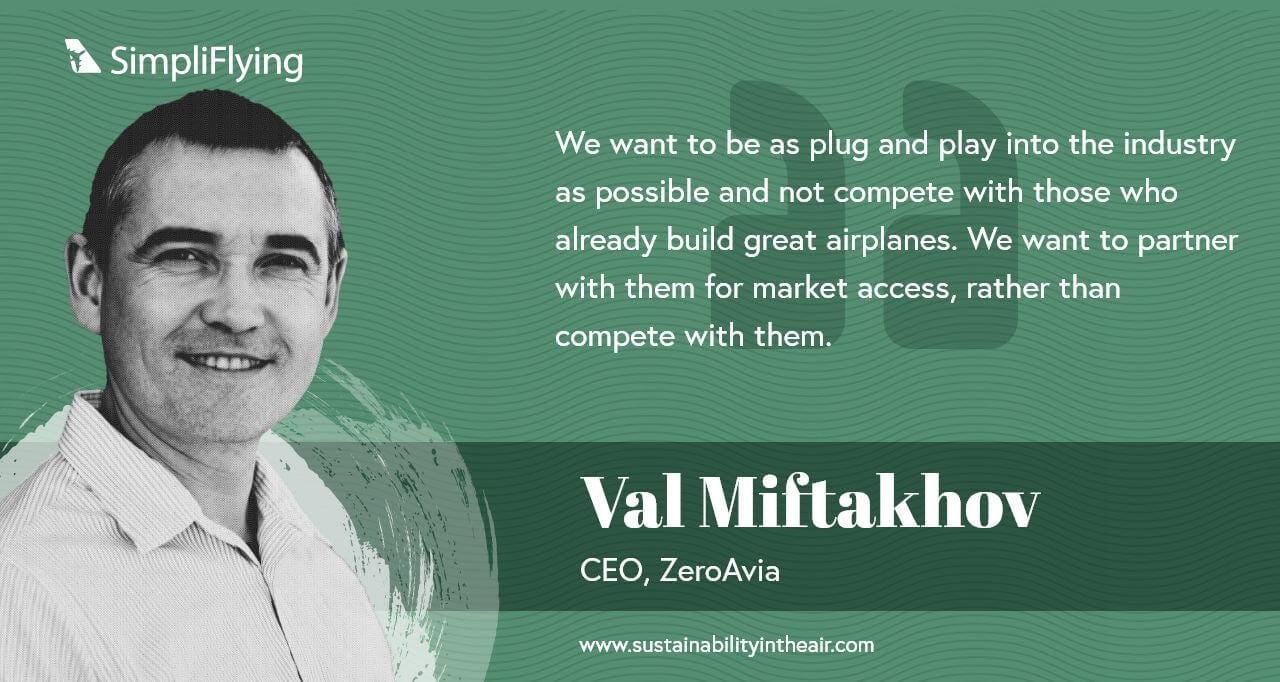Welcome to Season 2 of Sustainability in the Air, the world’s first podcast dedicated to sustainable aviation. Through in depth conversations with top aviation leaders, we break through the clutter and provide a clear roadmap for a net-zero future.
Nearly 2.1% of all human-induced CO2 emissions are produced by aviation. As the demand for air travel revives after the COVID-19 pandemic slowdown, sustainability concerns have become more pressing than ever before. With jet fuel at the heart of the sustainability issue, alternatives like hydrogen fuel cell engines seem better positioned to decarbonise aviation and minimise its negative environmental impacts.
ZeroAvia, a startup, has set out to create a breakthrough zero-emissions solution by replacing conventional aircraft engines with hydrogen-electric powertrains. These powertrains can be retrofitted to existing airframes and are powered using green hydrogen. ZeroAvia is currently developing 10-20 seat commercial aircraft with a 500-mile range, and has plans to expand to large turboprops and regional jets.
In this episode of our ‘Sustainability in the Air’ podcast, ZeroAvia CEO, Val Miftakhov speaks with SimpliFlying CEO, Shashank Nigam and discusses how hydrogen electric engines are the disruptive solution the industry needs to scale aviation for commercial use.
You can listen and subscribe to our podcast below or read our deep-dive into the episode.
If you’re rushed for time, you can also directly jump to your topic of interest by referring to these time-stamps:
Val’s experience in electrifying the automotive industry (1:55)
Hydrogen vs electric batteries (5:25)
Collaboration not competition: working with industry experts (10:20)
Hydrogen production — the distributed approach (14:10)
Zeroavia in 2030: visions for the future (21: 28)
Learnings from the non-fatal test flight crash and safety measures (24:03)
Tackling non-carbon emissions (31:00)
How much funding does ZeroAvia require? (34:58)
Challenges and hurdles (37:20)
The myths of Sustainable Aviation Fuels (42:18)
Disruptive technologies and dealing with the industry’s inertia (45:45)
Hopes about the future (48:50)
Rapid Fire! (50:48)
Zero-ing in on Hydrogen: Batteries & Retro-fitting
Drawing from his experience in the automotive industry, Miftakhov started ZeroAvia in 2017 to completely eliminate aircraft emissions, and not just reduce them by 2 or 3 per cent. A trained pilot, he flew some of the early test flights himself.
Miftakhov explains that while electric batteries are considered one of the best solutions to cut emissions and are extremely efficient for use in the automotive industry, their application in aviation isn’t very practical. Unlike their usage in cars, batteries would have to be recharged several times a day to support flights.
Moreover, since batteries typically begin to degrade after a 1,000-1,500 charging cycles, they would have to be replaced almost every six months! In addition, the energy density of even the best batteries is about 40 times less than that of jet fuel. Hydrogen, on the other hand, performs 3 times better than Jet A, and when used in conjunction with hydrogen fuel cells, proves to be the best energy source, Miftakhov asserts.
ZeroAvia’s approach has focused on retrofitting existing aircraft instead of building one from scratch, as it offers them the fastest route to market. The need to periodically replace aircraft engines also gives them the necessary window of opportunity to step in and plug their hydrogen-based systems. This approach also allows them to partner and collaborate with experienced engine and aircraft manufacturers to expand their base and does not position ZeroAvia as a competitor.
“We’re quite far along in what we’re doing. We have a great ecosystem around us. We have all these partnerships with the aircraft manufacturers… We have partnerships with the airports. We have partnerships, and customer relationships with a number of major airlines and operators. So I think on the propulsion side, we’re quite far along.”
Safety First
In April 2021, a ZeroAvia test plane lost power and suffered a non-fatal crash during flight tests. UK’s Air Accidents Investigation Branch (AAIB) completed its investigation into the incident a year later, and confirmed that the hydrogen system was not responsible.
Miftakhov says that while this re-affirms the company’s belief that hydrogen is safe – despite years of fear-mongering since the Hindenburg inferno in 1937 – the reality is that the crash was a sobering reminder of how much work remains to be done. While the technical cause of the crash was elsewhere in the system, Miftakhov admits that the sequence of actions by the crew was not optimal.
Since the crash, there has been a renewed focus within ZeroAvia to re-assess processes. The company has established a segregated flight testing department separate from the engineering department; requires proper sign-offs on flight test programs; and has refreshed the maintenance operation. In addition, the design department also underwent a review and the company underwent a number of visits and audits from regulators.
When it comes to the safety of hydrogen in commercial aviation, Miftakhov says that studies done by NASA conclude that hydrogen can be actually safer than jet fuel, even in aircraft. He even rattles off a long list of reasons why the physical properties of hydrogen make it safer. For example, it’s actually very hard to contain hydrogen in one place at a reasonable concentration. So even if there’s a leak, it escapes quickly and doesn’t pull on the aircraft like jet fuel would. Moreover, Miftakhov says that the automotive industry has also proven beyond doubt that hydrogen is safe – and there’s no reason why that can’t apply to aviation as well.
The myths of SAF: overhyped and unsustainable?
Miftakhov does not mince words when assessing airlines’ current approach to net zero. He believes the over-reliance on sustainable aviation fuel (SAF) is, ironically, unsustainable. While it may appear to be the only viable solution today, Miftakhov believes that it is fundamentally expensive and unviable in the long-run.
He believes SAF is a combustion solution with various adverse effects. Even if those effects were ignored, the efficiency of SAF production doesn’t add up as there isn’t enough raw material available sustainably. Miftakhov is certain that SAF is not a scalable solution simply because of how much of it will be required to significantly cut emissions.
In fact, even the synthetic route to SAF is fraught with challenges because of the complexity and costs of setting up a chemical plant with a product whose by-products may be unusable by other industries. This will likely drive up the cost of the fuel.
Miftakhov reiterates that a hydrogen electric propulsion system will be more cost efficient and won’t suffer from combustion effects. And while he admits this does require fuel infrastructure and a new propulsion technology, it’s a much better approach overall.
Non-carbon Emissions
Miftakhov emphatically suggests that hydrogen electric is significantly better than other systems such as hybrid electric. However, when it comes to climate impact, merely targeting carbon emissions is not enough. Non-carbon effects such as contrails that trap energy in the upper reaches of the atmosphere can have a significant impact on the environment as well.
Miftakhov says that there is now a scientific consensus that about two-thirds of the total aviation impact is due to these non-carbon effects. So just taking the carbon out of aviation will do some good but it’s just a third of the picture.
Most non-carbon emissions are due to the high pressure and high temperature reaction with air. A fuel cell that uses an electrochemical catalytic system operates at a much lower temperature than a thermal engine and, therefore, eliminates the possibility of these emissions.
Our Take
Disruptive technologies like hydrogen-electric are not very easily adopted (or “diffused”) in an existing system. A system may be defined as a network of interlinked actors and their activities. Legacy systems often resist change and are not very accepting of new processes and technologies. While some actors may be more resistant to change than others, until the system moves forward together, the rate of diffusion will remain low, and the system will remain “locked-in” the current jet-fuel intensive practices.
Radical and disruptive innovations require support and funding to compete with existing technologies. Promisingly, ZeroAvia has garnered massive support in the industry from airlines, OEMs and governments alike – for instance, they have received a ~$16.3 million grant from the UK Government; have investments from Breakthrough Energy ventures, Amazon and Shell; partnerships with leading airlines like British Airways, United Airlines, Alaska Airlines and American Airlines; and have also raised nearly $50 million in funding! This is a push in the right direction to enable the technology to grow.
ZeroAvia’s first hydrogen-powered aircraft will go into service in 2025. While there is substantive support in the industry for ZeroAvia, it remains to be seen whether their proposed powertrains will deliver on their gleaming promises in the proposed time frame.
References:
Fagerberg, J. (2006). ‘Innovation: A Guide to the Literature’. Oxford Handbooks Online. Oxford University Press. Doi: 10.1093/oxfordhb/9780199286805.003.0001.
Our Sustainability in the Air podcast is powered by SimpliFlying which has been helping build trust in travel for over a decade.
This season of the podcast is brought to you by CarbonClick, leaders in managing carbon offsetting programs for top global airlines.













